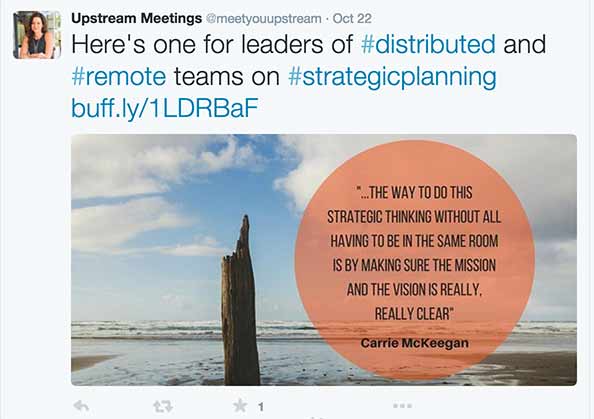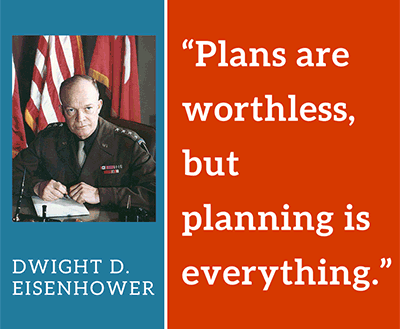Strategic Planning with Remote Teams: Does it really work?
One “Essential Strategic Plan” template, five meeting agendas that walk you through filling it out, seven blog posts, and a review of 26 online brainstorming tools, all combine to make up the Complete Toolkit for Strategic Planning with Remote Teams.
Today’s post is the last in our series. Now that we’ve got the whole package out there, it’s time to ask the hard questions.
- Does this approach to strategic planning actually work?
- Is the plan you get at the end worth the time it takes to create?
Designed by Anna O’Byrne at Upstream Meetings, the process outlined in the Toolkit is meant to help larger organizations conduct planning with a distributed workforce. For big companies, it provides an effective way to run the annual planning process and save thousands on travel costs.
The surprise for us was how well this process works for small businesses, regardless of whether they work remotely or all at one location. The Toolkit provides a do-it-yourself guide to planning that a busy small business can use to quickly create a usable plan. Broken out into several short sessions that run over the course of one to three weeks, this approach not only saves travel expenses, it also means you don’t have to shut down the company for a full day while your team plans.
This approach to planning is practical, affordable, and effective.
How do I know? We’re a small business, and we ran through the whole thing ourselves. Here’s our story.
Full Disclosure: Lest You Get the Wrong Idea
Before we dive into the story, I thought you should know more about how we got into this whole adventure in the first place.
The Lucid team writes about remote teams and meetings a lot. So does Upstream Meetings. One day, we both happened to share each other’s content on Twitter. I sent Anna a message and suggested we meet to learn more about each other.

The next week, we got on a call. Originally, Anna was going to interview our team about how we run strategic planning for her blog. She’s working to understand how this kind of planning works best with remote teams.
But the truth was, we didn’t really do “strategic planning” as I understood it, and I wasn’t sure why we would. In my experience, formal strategic planning was always a multi-day affair that yielded long-winded plans no one ever really followed.
Intrigued, I suggested we collaborate on a set of meeting templates that remote teams could use as an experiment.
For Anna, this was a way to explore and formalize her expertise in strategic planning, and specifically her specialized insight into running the process online. For us, it was an opportunity to work with a meeting designer from outside Lucid – something we’ve been working towards but hadn’t yet done.
No money exchanged hands, and you can get to all the templates for free. The basic agendas are posted on our website, and anyone with a Lucid account can use the meeting templates to run their planning sessions.
So – with that – here’s what happened when we ran them for ourselves.
A Case Study in Strategic Planning: Our Journey
At Lucid, every person on our core team helps ship product, works with customers, and keeps things running. We are never bored, never done, and blessed with a Cup of To-Do’s that most definitely runneth over.
When we began working with Anna on the Strategic Planning for Remote Teams templates, I was thrilled! Here was an opportunity to lay out an approach to strategic planning that was specific and detailed enough for people to actually use, but small enough that you could learn how to run the whole thing in less than an hour.
Then, I realized that we were going to have to test these templates ourselves before we could publish them. That meant that we needed to carve out time in the middle of everything else we were doing to run through the strategic planning process.
Oh crap. Our collective To-Do Cup just exploded.

Do we really need a strategic plan?
Yes, I could see how a strategic plan might be useful, but did we actually need one?
We already filled out our business model canvas and crafted an experience vision. We have a marketing plan, content plan and a full editorial calendar. Product roadmap and backlog? Hoo-boy do we have a roadmap!
We aren’t hurting for ideas or plans – but we sure could use extra hours in each day. Taking this time to create even more plans seemed indulgent at best and at worst, a foolish diversion.
Like most small businesses, we’d put off formal strategic planning for later.
Someday later when we were bigger. Someday later when we had some extra time. Someday later when we could afford to hire a facilitator that would walk us through the process. Someday later when it would be OK for the whole leadership team to leave the office and huddle together in a big room with some sticky notes, while the “rest” of the business just ran itself for a bit.
But here were these templates we needed to test. I admit, I briefly considered pretend testing the templates by having the team make believe we were planning for a new ice cream truck or an alpaca farm. But that wouldn’t really tell us if a team could get a truly useful result with this process.
It had to be a real test, and we had to do it.
In the end, I’m enormously grateful we did.
What happened during our tests
Defining the vision and mission
We started by scheduling and running through the meeting for defining our strategic vision. I created the agenda in our Lucid planning room, and skimmed Anna’s instructions for how to lead the discussion. The day before the meeting, I sent out invitations and asked everyone to do the prep work.
Starting completely from scratch, this meeting took me about 40 minutes to set up and prep for – using the template, you’ll spend half that. The rest of the team spent roughly 15 minutes each researching example vision statements from other companies to review in the meeting. The Mission-setting meeting took about the same amount of prep work.
I thought we’d breeze through these. I thought we all pretty much knew what our vision & mission were, and that this would just be an elaborate way to co-edit that shared idea into a cohesive sentence or two.
Not so much. Each meeting ran a bit longer than the 60 minutes we had planned – mostly because we found we had so much to discuss.
What we learned
1. We could not succinctly state our vision and mission, and we needed to.
Once upon a time we could rattle these off, but we’d evolved since then. Our team had changed, our product matured, and we work with a lot more interesting customers now. We had a new perspective and scope, but we hadn’t yet figured out how to clearly articulate that scope in a way we could share with others.
As soon as we worked through these meetings and wrote up our vision and mission, all kinds of conversations got a lot easier. Suddenly, we knew exactly how to describe our company when talking with analysts, partners, and prospective clients.
Even our networking lunches got easier, and for a bunch of introverts like us, that’s a big win.
2. Taking several days between sessions helped a lot.
We ran the Vision setting meeting on a Thursday. Outside of the meeting, we finalized the vision by sharing revisions back and forth on Slack. Then, we ran the Mission-setting meeting the next Wednesday during the time we normally set aside for our team meeting. This meant we didn’t need to take any extra time out of our work schedule to fit it in, and we had nearly a full week between sessions.
Bonus 1: Breaking these sessions up kept us from derailing other important work. We can’t afford to shut the office down for planning, and this way we didn’t have to. On one day, we even had time to release a whole new batch of product features after our strategic planning session.
Bonus 2: Our vision and mission got better with more time to reflect. We didn’t try to come up with the perfect statements all at once, and when we did get our vision down, we had time to sit with it before we started on the mission.
3. For our team, values and culture matter a whole lot.
Every time we brainstormed words and phrases the team felt should be in our mission and vision, we ended up with value statements. Authenticity, inclusiveness, empowering everyone, knowledgeable… it goes on.
This group cares a whole lot about how we work – how we treat our customers, how we treat each other, and how to provide really useful services that make a difference.
Before we could make real progress on our vision and mission, we had to connect with the integrity and meaning behind our work as expressed by our shared values.
Improve Your Skills with Meeting School
About Those Values
Time for another confession: We never tested the values-setting template.
Why? First, we talked about values so much during our vision & mission meetings that another full session devoted to the topic felt redundant.
Second, the final statements for each part of the plan never get written during the meeting anyway. After each planning session, one or two people take ownership for composing the final versions.
Third, it’s a leadership thing. You can write out your values on paper, but real culture exists in what you actually do every day. Who and what do we celebrate? When do we rejoice and when do we freak out? This meant our company values needed to be written and embraced first and foremost by our founders if this statement was going to mean anything to our real culture, because it’s the founders who do most of the rewarding and freaking out.
John and I drafted the values together, working off the group conversations in our vision and mission setting meetings. It’s Portland, there was beer involved, and we’re happy with the result. Review the post on setting your values for references and some other perspectives if this approach won’t work for you.
Defining our strategic goals and strategies
We headed into the final two meetings in the series more willingly. We’d been through the process a few times at this point, so it was easier to focus on the content. We also felt like we were making meaningful progress.
These planning sessions cover a lot more ground and go into more detail than any of the earlier meetings, so before scheduling them, we looked for the best online tools for brainstorming and decision making, then set the meetings for 10 days apart.
We ended up using both Lucid and GroupMap together to run these meetings. We started and ended the session in Lucid and relied on Lucid to support the audio and keep track of time. We then linked over to a pre-configured GroupMap session to run the brainstorming, grouping, and prioritizing part of the call.
The meetings went well and we’re definitely in better shape with our strategy now than we were before. That said, this part of planning, for us at least, didn’t provide the same kind of tidy and resounding wins. We didn’t walk out with a catchy description to share with the press this time, but the process of planning and working through all the options made us much clearer on what we need to be focusing on.
When it comes to detailed planning, I think Eisenhower may have said it best.

What we learned setting goals and strategies
1. Spend more time defining what a good goal and a good strategy look like for your organization.
As Anna talks about in her blog post, you can slice and dice this part of the plan many ways. Some companies have Objectives, Goals, and Key Results. In others, you’ll here them talk about their KPIs – yet another level of planning you can bring in.
We wanted to stick with the Essentials outlined in Anna’s template: high-level Goals with short term strategies to reach them. But when we got into brainstorming, it was clear we didn’t all agree on what constituted “high-level”, or on how measurable each item needed to be.
Also, for our business, it doesn’t make sense to plan out 5 years – or even 1 year – in advance. We planned instead through mid–2016. On that time frame, some of our initial strategies looked more like a glorified to-do list. We should have spent more time deciding exactly how to structure a good goal and a useful strategy for our company up front.
In the end, our plan includes 5 high-level goals that will take us some time to achieve. For each one, we defined a measurable objective for the current plan period, then set out strategies for hitting this near-term objective.
2. Setting goals is limiting. and liberating.
We work entirely online, where new ways to do better come out every day. We’re inundated with advice on how to write better content, drive more traffic, build faster software, design prettier buttons – the list goes on and on relentlessly.
While it can be inspiring to see all that’s possible should we have unlimited resources and time, the reality is that we only have time to excel in a few areas and have to be OK with ‘good enough’ in others.
We limited ourselves to setting just 5 goals, which meant there were another 10 we had to let go – limiting!
Could let go. Allowed ourselves to let go. Set free. Liberating!
3. Use the mission & vision to guide your decisions.
We felt strongly that it was important to focus in on a few key goals, but sitting here today we don’t actually know which of the goals will end up helping most should we achieve them.
To cull the list, we returned to our vision & mission. We asked ourselves “How does this goal help us achieve our mission, specifically?” Then we chose goals and strategies where this answer was obvious to everyone and ditched those where someone had to make a complicated case to explain why that work mattered.
4. Reconciling new strategy to existing plans gets messy.
Remember that before we began this process, we already had all kinds of detailed plans. When we went to set strategies, we had all this other stuff planned that we had to either incorporate into the new plan or let go.
We don’t get too hung up on plans themselves, and didn’t have any heartache over letting old plans go – so that wasn’t the issue for us. I could see how this could be a problem in organizations where people get territorial over their work, though.
Our challenge was fitting it all together in a way that made sense. Now, our Vision & Mission gave us a frame to plan within, and suddenly we had all these strategic puzzle pieces to fit in there. Turns out, some of our previous plans don’t fit into the picture we’re now trying to piece together – but figuring that out was tricky.
The Result: Our Strategic Plan
When it was done, we put our plan into Anna’s one-page Essential plan outline. I like big fonts, so our full plan doesn’t fit neatly onto a single page. You can see the longer-term parts here though – Vision, Mission, high-level Goals and Values – all of which will remain in place as we work through the short-term detailed plans.

Lucid Meetings Strategic Plan
- Vision:
- To transform what it means to run a successful meeting in the digital workplace.
- Mission:
- To build the world’s most inclusive, connected and informed online meeting platform, empowering people at all levels of an organization to readily lead exceptional work meetings.
- Values
- Embrace the four agreements, Actively choose your impact, Use process to set you free, Work together to accomplish more, and Lighten Up 🙂
- Platform Goal
- Ongoing development focused on reliable ease-of-use, connection to business systems, and meeting design.
- Partnerships Goal
- Build a mutually beneficial network of content, referral and technical partnerships.
- Customers Goal
- Grow and retain a profitable customer base of SMB organizations.
- Community of Practice Goal
- Establish a mutually supportive community for those designing and leading business meetings.
- Operations Goal
- Develop sustainable and resilient business operations.
All together, we spent 7 hours preparing for and running these meetings over the course of a month – less time out than we’d have spent in a one-day workshop. John and I took responsibility for finalizing the plans and putting them into presentations, which took another 8 to 10 hours.
To revisit the big question: was this time well spent?
Yes.
We clearly learned a lot, and that kind of learning is essential to running an effective knowledge-based business.
More directly impactful: we’ve changed what we’re working on each day. Not in big ways, but in a multitude of small ways that keep our focus squarely on achieving our company goals.
We also know better which of the many metrics we track really matter, not because some industry blogger says we should care about them or for bragging rights, but because these numbers are the mileposts along the road we choose to follow, measuring how far we’ve come on our journey.
Take-away: Right-sized planning
The traditional approach to strategic planning that you see in large organizations is overkill for smaller businesses; it’s too expensive, too time consuming, and creates big plans that small teams can’t meaningfully put to use.
The Complete Toolkit for Strategic Planning with Remote Teams takes the best parts of this process and distills it down to the essentials. It’s not too overwhelming nor too shallow, just the right amount of planning to help keep a group focused on a common mission.
We’ve found Anna delightful to work with, and helpful each time we had questions. As a small company, we benefited from the work she did as a trained facilitator to translate the process for use online, and her simple do-it-yourself instructions that made it easy to fit into our busy schedules. And because she so clearly knows both strategic planning and remote work, we wouldn’t hesitate to call on her again if we wanted outside help running our planning meetings next year.
And that’s it. If you have any remaining questions about our experience with the strategic planning series, leave us a comment below, contact us by email, or catch us on Twitter. We’d love to talk more.
Finally, if you’re the DIY type and ready to get going, check out the Toolkit, then share your experience. We want to hear your ideas for making this even more useful going forward.



